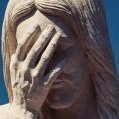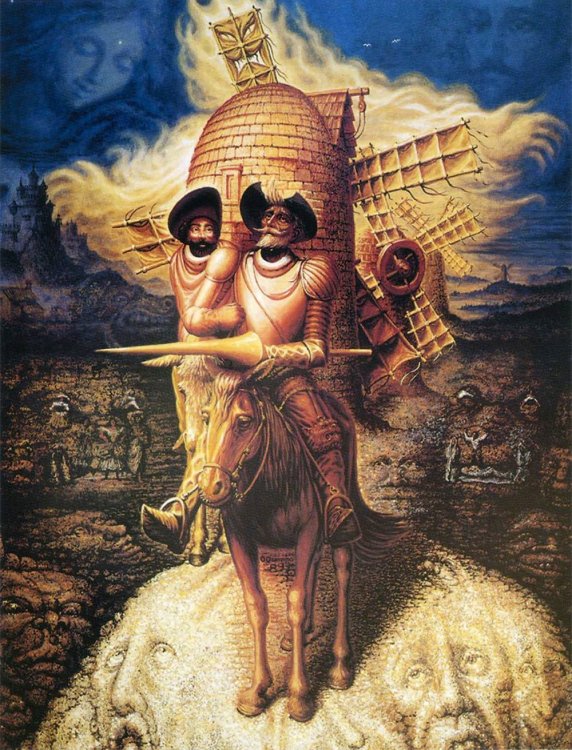Leaderboard
Popular Content
Showing content with the highest reputation on 03/09/23 in all areas
-
Numbers (real numbers) are not atoms, they're not beads on a string, they're not pieces of code on a DNA strand, they're not characters on an alphanumeric string. They're abstractions. That's, I think, at the root of why you're finding it so hard to wrap your head around the ideas that define them. Same reason why people I will describe in anecdote a1) at the end of this post, completely missed the point too. So you're not alone. Axiom of completeness: (1) Semi-intuitive notion: Real numbers have no gaps or holes (2) Rigorous notion: Every nonempty subset \( X \) of \( \mathbb{R} \) that is bounded above has a least upper bound. That is, \( \sup X \) exists and is a real number. Consider this sequence --not made up of atoms, nor made up of beads, nor made of little LED lights; made up of numbers--, \[ X=\left\{ x\in\mathbb{Q}/x=1-\frac{1}{n},n\in\mathbb{N}\right\} \] In other words, \[ X=\left\{ 0,\frac{1}{2},\frac{2}{3},\frac{3}{4},\frac{4}{5},\frac{5}{6},\frac{6}{7},\frac{7}{8},\cdots\right\} \] Now consider the following facts: A) Every number in \( X \) is less than 1. B) For every \( r \) such that every number in \( X \) is less than \( r \), \( r\geq1 \). That means that 1 is not only an upper bound to \( X \); it is, actually, the best upper bound we can find. That is, 1 is the least upper bound. Challenge: Find a number in \( X \) that gives you exactly 1. If you get to understand how you will fail to find that number, say \( x_{n}=1-\frac{1}{n} \), you will be a step closer to understanding this logical frustration. Let me finish with a couple of anecdotes: a1) I was once sitting at a Calculus class and the professor told us about the axiom of completenes in the form, "every monotonically increasing sequence in the real numbers possesses a least upper bound." A couple of students in front of me started giggling and went something like, "Doh! Why of course." Needless to say, they'd completely missed the point. a2) Our Electricity and Magnetism professor said. "Imagine an R, RC, or LRC circuit with an amperimeter. You measure the current and it gives 1.3 Amperes. What kind of number is that? Is it real, rational, imaginary? After a prolongued murmur somebody uttered: It's a real number. The professor said: "No, it's neither one of them. It's a measured number." Don't let the adjective 'real' deceive you. They're real alright. In some sense.3 points
-
1 point
-
I don’t know about “fundamental”, but ultimately this reality-modelling machine is a result of the process of evolution. What this means is that its function is not at all to neutrally reflect “external reality as it is”, but rather to present us with a model of external reality that is specifically geared towards survival and procreation, and as such will be filtered, distorted, and pre-digested accordingly, with this goal in mind (pun fully intended). For example - out in the jungles and savannahs where we originally came from, if you encounter other members of your species with whom you compete for limited resources, it is advantageous for you to have available a model that allows you to (at least to some degree) predict their intentions, mind-states, and possible future actions. Likewise with the flight path of an arrow, the weather, the behaviour of water in a river etc etc. If you have good models available that take sensory inputs, processes them, and generates something that allows for predictions of how your environment will evolve into the immediate future, you’ll simply have much better odds to do well and thrive, evolutionary speaking. So it’s actually not a surprise at all that things are as they are. As a little aside: I, as being on the autism spectrum, am missing a part of this reality-modelling machine - when I encounter another human being, I am socially blind; I generally have no intuitive concept whatever about what kind of mind-state that individual might currently have, I might as well be looking at a stone statue. I don’t immediately know their intentions, nor can I easily tell how they will behave in the next few seconds. All I can do is make educated guesses based on experiences gathered during previous interactions I have had with people; but this takes an active and conscious effort, and sometimes I get it quite wrong. It’s called “mind-blindness”. This is part of the reason why autistic people often struggle with social interactions.1 point
-
That's not just old people; that applies to most homeless people. Something bad happened, then another bad thing and another, they lost control of their life, had a breakdown or self-medicated to excess, until finally, they couldn't afford the mortgage or the rent and utilities.... The cracks keep getting wider and more people fall through.1 point
-
Say we start at x = 1/2. Then repeating the "half the distance" idea gives 3/4, 7/8, 15/16, 31/32, ... We get an infinite sequence of points, each one a little closer to 1, but none of them is the largest in [0,1). This is vague. Numbers aren't "attached to" each other as if by velcro for example. Didn't the two-dimensional example of the boundary of a circle help? Sometimes geometric intuition is helpful. Sometimes it's confusing. What is the formal definition of [0,1)? It's [math]\{x \in \mathbb R : 0 \leq x < 1\}[/math] That denotes the set of all real numbers greater than or equal to 0, and strictly less than 1. There's no "attachment" in the math. Just a set of real numbers. By the way this is set theory notation, since you mentioned Zermelo-Fraenkel. The curly brackets denote a set. The colon is read, "such that." The boldface [math]\mathbb R[/math] stands for the real numbers. So the notation literally denotes "The set of all real numbers x such that" etc. This analogy doesn't work for me. For one thing, water isn't the real numbers. Water is made of discrete molecules and exists in the physical world; while the real numbers are a mathematical abstraction that, as you note, form a continuum. But even on its own terms, the water analogy doesn't work. If you zoom in to the "surface" of a body of water, you find a cloud of molecules that aren't part of the body of water, but are in the process of evaporating into the air. In fact the surface of a body of water very nicely models an open set with no boundary at all. The surface is fuzzy, with molecules constantly jumping around and some of them escaping into the surrounding air. I don't understand it either, as shown by my example of zooming in to the "surface" to see a cloud of molecules leaving the water and evaporating into the air. There is no well-defined surface of a body of water. Now perhaps you are thinking of surface tension, but still, the analogy is strained. If you zoom in, you see molecules bouncing around. You can never point to any one collection of molecules and say, "That's the surface." Before you're done speaking, some of those molecules have evaporated into the air.1 point
-
How old a kid? When I was 10, we packed a minimum of belongings and left our home. I was very much aware that we would never go back, never see that apartment, or that city, ever again. It was terrifying, even though I was with both my parents. My brother was 5, and pretty much took things as they came. Later, he had only scrappy memories of the next eight months, while I retain every landscape, voyage and temporary shelter to this day. I do understand why some old people, on losing their home, lose the will to live. And why people with mental health issues can't possibly get better until they have a safe place of their own. Not an institution, not a hostel, not a rehabilitation camp with bunk beds - a room with a door they can lock and a light they can turn out or leave on and a bed where nobody else is allowed to crash, except by their invitation.1 point
-
..can't you see the faces in these pictures? Don Kichot picture has more than 20 faces.. Birds are eyes, noses and lips.. This is thread about pattern recognition by the brain. A pretty good bit of science.. https://en.wikipedia.org/wiki/Pattern_recognition_(psychology)#Facial_pattern_recognition1 point
-
The point here is that, after we go beyond the integers, we are never looking for a 'next' number because we never start with just one number. We need to employ two numbers. It works like this. All number systems inherit properties from simpler systems from which they are built. We cannot build the integers without the natural numbers. We cannot build the rational numbers without the integers. I will take these as read and proceed to the rational numbers. We define a rational number as the ratio of two integers. It has to be integers since we are defining 'fractions' so we cannot employ fractions in our definition or it would be a circular definition. We define one rational number a/b as being greater than another , c / d, where a,b,c,d are all integers [math]\frac{a}{b} > \frac{c}{d}\quad if\quad ad > bc[/math] We can use this to find a third rational number between any two rational numbers as [math]\frac{a}{b} > \frac{{a + mc}}{{b + md}} > \frac{c}{d}\quad if\quad b,d,m\;are\;positive\;{\mathop{\rm int}} egers[/math] I suggest you practice some algebra by convincing yourself my formulae are good. We can repeat this process indefinitely, placing a fourth rational number between our first and third or second and third rational numbers. This leads to the conclusion that between any two rationals there is another and by extension infinitely many other rationals. This density property amounts to saying that, for the rationals, there is no 'next' number to any rational since given any proposed next rational we can place another closer, by this process. So let us move on to the set (I learned class) of all rational numbers and divide it anywhere into two subsets. This is actually where a number line comes in handy since we can call the subset to the left of our dividing line L (with typical element l) and the subset to the right R( with typical element r). Because we have divided the line to the left and right, any l < any r. Now for the clever bit. If we pick one rational from each of L and R, say l and r then we can examine the infinity of rationals between l and r according to our formula above. Each and every one of these must individually belong to either L or to R, but not to both. There can be no rational numbers belonging to both L and R. This means that we have an infinite sequence of increasing rational numbers greater than l in L And an infinite decreasing sequence of rational numbers less than r in R So L has no greatest element And R has no least element So we have created two open sets and sequences a la Genady. This density property is inherited by the reals from the rationals, as noted at the beginning of this post. As also noted the fun starts when we try to incorporate irrational numbers into the scheme as the next post will show, with the story of root2 - the first irrational to be discovered. Again this is where geometry helps explain things.1 point
-
1 point
-
Thanks, added to https://en.wikipedia.org/wiki/Mirror_life ... mirror microbe by 2040?1 point
-
Neutrinos are ghostly subatomic particles existing in quantum superposition. Right now 100 billion neutrinos are passing through your thumbnail every second. 8.5 minutes ago they were in the heart of the Sun.-1 points
-
The ekpyrotic model proposes that the universe has no beginning or end. Instead of a bang, what happened is thought of as a "Big Bounce", the moment at which the universe, which was slowly contracting to an incredibly, but not infinitely, small point, bounced to expansion. There is no beginning of time. Instead, our visible universe exists on one of two four-dimensional "branes" floating in a five-dimensional space.The ekpyrotic universe theory asserts that the cosmos exists as a product of an endless procession of creation, destruction and recreation. This model theorizes that the universe has been expanding and contracting repeatedly over time scales that make the 13.7 billion years that have passed since the Big Bang seem like a second.-1 points
-
There are at least 10 sextillion stars in the entire universe. That's 10 followed by 22 zeros. This number is thousands of times larger than all the grains of sand on all the beaches on Earth.-1 points
-
Light is made out of small quantum objects called photons. When you turn on a lamp, the light bulb begins creating and emitting trillions upon trillions of photons. Photons are in a class of quantum particles known as bosons.-1 points












